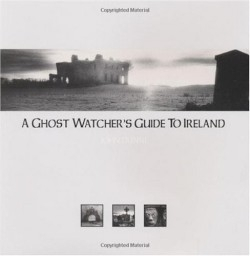
A Ghost Watcher's Guide to Ireland
If there are no ghosts in the pictures that illustrate this book, it certainly looks as though there might be. These atmospheric photographs are often eerily beautiful and might very well be worth the cost of the book. The dreamlike effect is achieved by shooting black and white photographs on infra-red film, which records what is known as near-visible light; anything white or light in color—gravestones, for instance—will reflect infra-red and print as a frosty white in the final image, while clear skies and water will show up dark or black. In other words, this is the perfect film for shooting ghosts—or providing ghostly images.
Marsden’s photographs of unnamed castle ruins, anonymous graveyards, and non-specific Celtic crosses illustrate an Ireland that predates the roaring Celtic Tiger of the last decade. The book was published posthumously: John Dunne, a well-known writer, journalist, and broadcaster, died before publication. The text is, in a manner of speaking, its own ghost, resting peacefully in the past of a country determinedly marching toward the future.
Accompanying those photographs, the text offers a specificity that is strangely lacking in atmosphere: “There is no explanation for the ghostly noises that echo through the ancient top floor of Foulksrath. Black Thomas Ormonde himself was captured in nearby Kilkenny city, Kyteler’s Inn is redolent of the activities of Dame Alice Kyteler, who, in 1324 was accused of witchcraft.”
We hear no more of Black Thomas or Dame Alice, just that they were captured and accused. They bear no relation to the story that follows of thwarted lovers who, separated by a cruel father, communicate by way of a cuckoo, “although how this link was achieved is not clear.” They later married and lived, as far as we know, happily ever after. As to the ghost whose footsteps are said to be heard on one particular night in November, the warden of the hostel that now occupies the castle says, “We’ve been here two years…and haven’t heard the ghost yet.”
Perhaps this is what happens when a journalist tells a ghost story: the desire to know who, what, when, etc. is a habit that is apparently hard to break. But that clear-headed search for facts sucks the life, so to speak, out of a ghost story. Fuzziness, as the pictures demonstrate, can be very suggestive.
Reviewed by
Jeannette Boyne
Disclosure: This article is not an endorsement, but a review. The publisher of this book provided free copies of the book to have their book reviewed by a professional reviewer. No fee was paid by the publisher for this review. Foreword Reviews only recommends books that we love. Foreword Magazine, Inc. is disclosing this in accordance with the Federal Trade Commission’s 16 CFR, Part 255.
